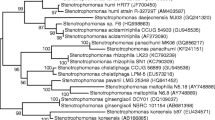Abstract
The biosynthesis of algicides produced by a novelFischerellastrain was investigated. Two allelochemicals were identified, the aminoacylpolyketide fischerellin A (FsA) and the alkaloid 12-epi-hapalindole F (HapF). Based on the structure of FsA, genes that could be involved in its biosynthesis, including those encoding nonribosomal peptide synthetases (NRPSs) and a polyketide synthase (PKS), were identified by the polymerase chain reaction (PCR). By showing that the expression of NRPSs and PKSs is concomitant with algicide production we suggest that the identified genes may be involved in algicide biosynthesis. Analysis of an algicide preparation of the Brazilian-Amazonian strainFischerellasp. CENA 19 revealed the production of FsA,m/z409 (MH+), HapF,m/z370 (MH+), and other potential isoforms of the latter compounds, which were identified by high-performance liquid chromatography (HPLC) and matrix-assisted laser-desorption ionization time-of-flight (MALDI-TOF) mass-spectrometry. The production of HapF was confirmed after purification by HPLC, analysis by NMR, and high-resolution mass-spectrometry (HRMS). Two-NRPS and a PKS gene were identified after specific amplification using a degenerate PCR. The expression of these synthetases was confirmed by Western blot analysis employing enzyme family-specific antibodies. These analyses revealed the presence of three NRPSs and a single PKS inFischerellasp. CENA 19. The structure of FsA indicates both aminoacyl- and polyketide moeities, suggesting that its biosynthesis may require an integrated NRPS/PKS enzyme system, possibly involving the genes and the synthetases identified.
Similar content being viewed by others
References
Allen MM (1968) Simple conditions for growth of unicellular blue-green algae on plates. J. Phycol. 4: 1–4.
Allen MM, Arnon DI (1955) Studies on nitrogen-fixing blue-green algae. I. Growth and nitrogen fixation byAnabaena cylindrica,Lemm.Plant Physiol. 30: 366–372.
Beyer S, Kunze B, Silakowski B, Müller R (1999) Metabolic diversity in myxobacteria: Identification of the myxalamid and stig-matellin biosynthetic gene cluster ofStigmatella aurantiacaSg a15 and a combined polyketide-(poly)peptide gene cluster from the epothilone producing strainSorangium cellulosumSo ce90. Biochim. Biophys. Acta 1445: 185–195.
Caffrey P, Bevitt DJ, Staunton J, Leadlay PF (1992) Identifica-tion of DEBS 1, DEBS 2 and DEBS 3, the multienzyme polypeptides of the erythromycin-producing polyketide syn-thase fromSaccharopolyspora erythraea. FEBS Lett. 304: 225–228.
Cane DE, Walsh CT (1999) The parallel and convergent universes of polyketide synthases and nonribosomal peptide synthetases. Chem. Biol. 6: R319–R325.
Challis GL, Ravel J (2000) Coelichelin, a new peptide siderophore encoded by theStreptomyces coelicolorgenome: Structure prediction from the sequence of its non-ribosomal peptide syn-thetase. FEMS Microbiol. Lett. 187: 111–114.
Doan NT, Stewart PR, Smith GD (2001) Inhibition of bacterial RNA polymerase by the cyanobacterial metabolites 12-epi-hapalindole Eisonitrile and calothrixin A. FEMS Microbiol. Lett. 196: 135–139.
Du L, Sánchez C, Shen B (2001) Hybrid peptide–polyketide natural products: Biosynthesis and prospects toward engineering novel molecules. Metabol. Eng. 3: 78–95.
Etchegaray A, Dieckmann R, Engel PC, Turner G, von Döhren H (1998) Group specific antibodies against the putative AMP-binding domain signature: SGTTGXPKG in peptide synthetases and related enzymes. Biochem. Mol. Biol. Intern. 44: 235–243.
Fiore MF, Moon DH, Tsai SM, Lee H, Trevors JT (2000) Miniprep DNA isolation from unicellular and filamentous cyanobacteria. J. Microbiol. Meth. 39: 159–169.
Gorham PR, McLachlan J, Hammer UT, Kim WK (1964) Isolation and culture of toxic strains ofAnabaena flos-aquae(Lyngb.). Verh. Int. Verein. Theor. Angew. Limnol. 15: 796–804.
Hagmann L, Jüttner F (1996) Fischerellin A, a novel photosystem-II-inhibiting allelochemical of the cyanobacteriumFischerella muscicolawith antifungal and herbicidal activity. Tetrahed. Lett. 37: 6539–6542.
Kleinkauf H, von Döhren H (1996) A nonribosomal system of pep-tide biosynthesis. Eur. J. Biochem. 236: 335–351.
Laemmli UK (1970) Cleavage of structural proteins during the as-sembly of the head of bacteriophage T4. Nature 227: 680–685.
Marwah JB, Shakila TM, Rao NS, Bagchi SN (1995) Detoxifica-tion of a localMicrocystisbloom by an algicidal antibiotic fromOscillatoria late-virens. Ind. J. Exp. Biol. 33: 97–100.
Moore BS (1999) Biosynthesis of marine natural products: Microor-ganisms and macroalgae. Nat. Prod. Rep.16: 653–674.
Moore RE, Cheuk C, Yang X-QG, Patterson GML (1987) Ha-palindoles, antibacterial and antimycotic alkaloids from the cyanophyteHapalosiphon fontinalis. J.Org. Chem. 52: 1036–1043.
Papke U, Gross EM, Francke W (1997) Isolation, identification and determination of the absolute configuration of fischerellin B: A new algicide from the freshwater cyanobacteriumFischerella muscicola.Tetrahed. Lett. 38: 379–382.
Porto ALM, Machado SMF, de Oliveira CMA, Bitrich V, Amaral MCE, Marsaioli AJ (2000) Polyisoprenylated ben-zophenones fromClusiafloral resins. Phytochemistry 55: 755–768.
Schlegel I, Doan NT, de Chazal N, Smith GD (1999) Antibiotic activity of new cyanobacterial isolates from Australia and Asia against green algae and cyanobacteria. J. Appl. Phycol. 10: 471–479.
Silakowski B, Schairer HU, Ehret H, Kunze B, Weinig S, Nordsiek G, Brandt P, Blöcker H, Höfle G, Beyer S, Müller R (1999) New lessons for combinatorial biosynthesis from myxobacteria: The myxothiazol biosynthetic gene cluster ofStigmatella aurantiacaDW4/3-1. J. Biol. Chem. 274: 37391–37399.
Srivastava A, Jüttner F, Strasser RJ (1998) Action of the allelochem-ical, fischerellin A, on photosystem II. Biochem. Biophys. Acta 1364: 326–336.
Stratmann K, Moore RE, Bonjouklian R, Deeter JB, Patterson GML, Shaffer S, Smith CD, Smitka TA (1994) Welwitindolinones, un-usual alkaloids from the blue-green algaeHapalosiphon wel-witschiiandWestiella intricate: Relationship to Fischerindoles and Hapalindoles. J. Am. Chem. Soc. 116: 9935–9942.
Tang L, Shah S, Chung L, Carney J, Katz L, Khosla C, Julien B (2000) Cloning and heterologous expression of the epothilone gene cluster. Science 287: 640–642.
Tillett D, Dittmann E, Erhard M, von Dohren H, Borner T, Neilan BA (2000) Structural organization of microcystin biosynthesis inMicrocystis aeruginosaPCC7806: An integrated peptide–polyketide synthetase system. Chem. Biol. 7: 753–764.
Turgay K, Marahiel MA (1994) A general approach for identifying and cloning peptide synthetase genes. Peptide Res. 7: 238–241.
Author information
Authors and Affiliations
Rights and permissions
About this article
Cite this article
Etchegaray, A., Rabello, E., Dieckmann, R. et al. Algicide production by the filamentous cyanobacteriumFischerellasp. CENA 19. Journal of Applied Phycology 16, 237–243 (2004). https://doi.org/10.1023/B:JAPH.0000048509.77816.5e
Issue Date:
DOI: https://doi.org/10.1023/B:JAPH.0000048509.77816.5e




